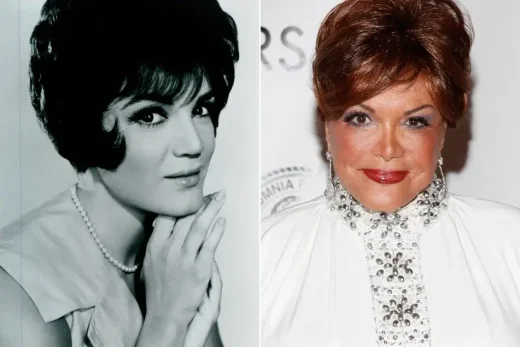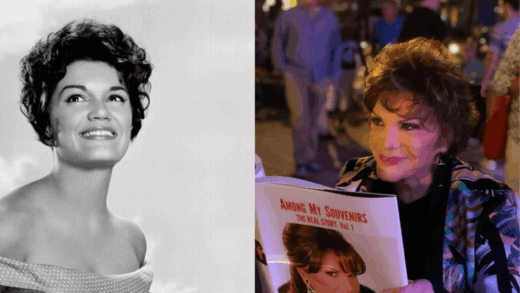When you think of golden-era music, one voice cuts through generations with clarity, sorrow, and charm: Connie Francis. Famous for hits like Who’s Sorry Now?, Stupid Cupid, and Pretty Little Baby, she was a household name long before streaming or social media. Yet, in an unexpected twist, her song Pretty Little Baby went viral on TikTok in 2025 just weeks before her death introducing her to a new generation who fell in love with her all over again.

As tributes pour in following her passing on July 16, 2025, many are reflecting not only on her powerful voice and influence, but also on the personal struggles she endured behind the spotlight. From mental health battles and sexual trauma to the risks of cosmetic surgery that nearly cost her career, Connie’s story is a profound reminder of resilience, vulnerability, and the price of fame.
A Voice That Defined an Era
Born Concetta Rosa Maria Franconero in Newark, New Jersey, in 1937, Connie Francis became one of the first female pop icons in American history. Her breakout moment came in 1958 when Who’s Sorry Now? a song she initially hated exploded in popularity thanks to a boost from American Bandstand. From there, her career skyrocketed.
Between 1958 and 1964, she racked up 35 Top 40 hits, recorded in more than 15 languages, and became a global star before turning 30. Her emotional delivery, slight vibrato, and girl-next-door beauty made her a sensation across the U.S., Germany, Italy, and Japan.
Tragedy Behind the Spotlight
Yet fame couldn’t shield Connie from the storms of life. In 1974, after a performance in New York, she was sexually assaulted in her hotel room, a traumatic event that led her to withdraw from the public eye. The trauma sparked years of depression, anxiety, and ultimately a battle with mental illness that would shadow her for decades.
Her openness about the assault was groundbreaking in an era when victims were often silenced. Later, she became an advocate for women’s safety and mental health, helping to destigmatize topics that were taboo at the time.
Connie Francis and Plastic Surgery

In 1977, Francis decided to undergo plastic surgery to refine her appearance and possibly revitalize her on-stage image. Among the procedures, she is known to have had nasal surgery and some reported facial contouring, likely around her chin and cheekbones.
But the results were anything but rejuvenating.
One of the surgeries meant to enhance her looks permanently damaged her nasal passages, affecting her vocal resonance. In an air-conditioned environment, her voice would vanish completely. For a singer, it was devastating. She later described the aftermath as the darkest period in her life, not only because her career paused for nearly seven years, but because she felt robbed of the one thing that gave her identity: her voice.
Connie Francis Before and After Surgery
Photos of Connie Francis before and after plastic surgery show subtle yet noticeable changes. In her earlier years, her nose had a more natural Roman contour. After the rhinoplasty, it appeared more refined, but possibly too narrow to support vocal performance. Her cheeks and jawline also seemed tighter, suggesting early facial lifting or filler procedures though not confirmed.
In an era without social media filters or non-invasive options like today, these surgeries were high-risk. Unfortunately, in Connie’s case, the physical transformation came at a cost to her career and emotional wellbeing.
A Return to the Stage and Another Tragedy
In 1981, after several corrective surgeries and vocal therapy, Connie returned to performing. But just as she began to heal, another tragedy struck: her brother, George Franconero Jr., was murdered in what was later determined to be a mafia-related hit. This loss shattered her once again.
In the years that followed, Connie was involuntarily committed to psychiatric institutions several times. Misdiagnosed with schizophrenia, she later revealed that many of her struggles stemmed from post-traumatic stress disorder, a diagnosis barely recognized at the time, especially for public figures.
Despite it all, she kept going.
A Surprising Second Act: TikTok, Gen Z, and Pretty Little Baby
Just months before her death, a quiet storm was brewing on social media. In early 2025, a soft, dreamy ballad called Pretty Little Baby originally released in 1962 started trending on TikTok. It featured Francis’s smooth, intimate vocals paired with dreamy instrumentation. Within weeks, the track had over 10 billion views across platforms.
Young creators used the sound to accompany nostalgic or romantic videos. Influencers like Kylie Jenner and Emma Chamberlain even featured it in reels, breathing new life into a forgotten B-side single.
Connie, then in her late 80s, was stunned. In an interview with her label, she admitted: “I don’t even remember recording it.” But she was deeply moved by the response. At a time when many aging icons fade from memory, Connie Francis was trending, her voice once again celebrated by millions.
Final Days and Farewell
In the spring of 2025, Connie was admitted to a Florida hospital for complications from a pelvic fracture and pneumonia. Despite showing signs of improvement, she passed away peacefully on July 16, surrounded by close friends.
Music historians, fans, and industry insiders flooded social media with tributes. The consensus was clear: Connie Francis wasn’t just a star of the past, she was a timeless force, whose impact would echo long after her final note.
Connie Francis’s Legacy in Today’s Cosmetic Era
Looking back at Connie Francis’s life, her experience with plastic surgery feels eerily relevant today. While technology has improved and non-invasive treatments dominate the scene, her story underscores a powerful truth: aesthetic enhancement should never come at the cost of physical or emotional health.
In a world obsessed with youth and perfection, Connie’s life reminds us that beauty is complex, and its pursuit, especially in public life can be risky.
Her decision to undergo surgery wasn’t unusual for a star in the ’70s, but the consequences of an unsuccessful procedure, especially one that affected her profession, offer a cautionary tale even today.
From Icon to Inspiration

Connie Francis’s life was filled with highs and lows, beauty and pain, fame and solitude. But above all, it was defined by her voice both literal and metaphorical.
She sang through heartbreak. She fought through trauma. She reinvented herself time and again.
And even when time silenced her microphone, social media brought her voice back.
At Erdem Hospital, we believe that every transformation cosmetic, emotional, or spiritual deserves compassion, safety, and expertise. As we remember Connie Francis, we honor the courage it takes to reclaim one’s story, and the timeless beauty of a voice that refuses to be forgotten.